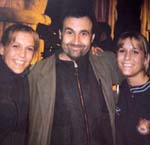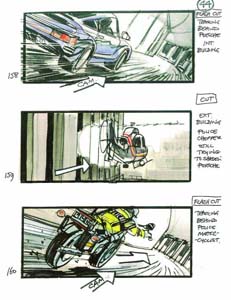
Jan Bursey in her Los Angeles office!
In the last decade, the means by which independent films, documentaries and screenplays are financed, advertised, marketed and sold has undergone tremendous change – which has developed the need for a new approach – Jan Bursey, President of USA-based Winter Palace Films
FILM AND FILMMAKER REPRESENTATION
In the last decade, the means by which independent films, documentaries, and screenplays are financed, advertised, marketed and sold has undergone tremendous change. With more than 20,000 films being produced annually competing for distribution deals independent filmmakers’ opportunities to have their scripts produced or films released into the marketplace are almost unrealistic and “great expectations”.
Independent films, documentaries, and screenplays usually do not have the luxury of being backed by studios, mini-majors, or large production companies with an internal infrastructure of creative, production, financing, advertising, public relations, and marketing executives and staff, and are benefitting from the delegation and compartmentalization of these necessary producing functions. When often times, filmmakers’ films and screenwriters’ screenplays needing representation to garner success are deemed unsolicited projects hindering their production and distribution or eliminating them entirely from the film market these functions, now more than ever before, filmmakers need to reflect in their film’s production budget.
So, what are the filmmaker’s options for representation in today’s film market? There are the various agents who represent seasoned filmmakers, and there are agencies searching for viable projects for packaging. There are film sales agents who usually handle multiple projects where little advertising and marketing is applied. There are producers’ representatives who offer more consultatory services than sales agents. There are producers of marketing and distribution (PMDs) who market filmmakers’ projects to distributors. And there is another entity, a full service advertising and marketing representation company geared toward gaining distribution for film and television through exploitation. This entity is referred to as a Producer of Advertising for Marketing for Film and Television Distribution, or in acronym is referred to as a PAMFTD and pronounced PAM-F-T-D, also shortened by popular demand to PAMD, PAM-D or sometimes called “The Pammy”.
One may ask, what is the difference in advertising and marketing? Isn’t it the same thing? The answer is they are different tasks. Marketing is the provision of goods or services to meet customer or consumer needs while Advertising is the activity of attracting public attention to a product or business by creating materials for paid or unpaid announcements in print, broadcast, or electronic media. So in effect, one is the offering of the product and the other is creating the desire or recognition for the need of the product.
A PAMFTD may also be considered in certain circumstances an Executive Producer for the film project by supplying a major portion of the film’s funding either before production, during completion, or after completion on films with deferred payment arrangements and investors expecting returns.
WHEN DO YOU NEED A PAMFD?
Let’s say you’ve just finished your screenplay and now face the daunting task of finding financing, or arranging for production, or want to get it sold, or let’s say you’re prepping your film, or you’re shooting your film, or you’ve completed it and have investors or deferred payments to crew needing their return or payment… and, you want your film seen! But, have you really done everything…or have you done anything needed to ensure its eventual success beyond the creative aspect? Do you have representation, or do you have the right representation to introduce your screenplay or film to its audience? Do you know how to market your finished masterpiece or who would buy it, or which contests, festivals, film markets, sales agents or distributors are most appropriate for it? Do you know how to present a budget or a business plan? Do you have all of the required distribution deliverables and documentation? Do you have the right images for key art? Do you know anything about funding and distribution options? Do you know how to package your film? You may need a PAMFTD as soon as you complete your script for either sales representation, financing or packaging for production as they will guide you through the processes of advertising it in various media platforms as well as funding options, sales, budgeting, development and business plan development.
You may discover you need an embedded PAMFTD to monitor your film’s overall advertising, marketing and distribution strategy, and working as a fulltime producer during the film’s production to manage the micro aspects of the film’s distribution ‘rollout.’ This requires usually a three-month commitment to the PAMFTD from the film’s production budget, and is only in place during production with the possibility of continued contractual representation after post-production or until a distribution deal is struck.
You may decide on a more a la carte representation for your film’s advertising and marketing distribution strategy where the advertising elements are supplied to the PAMFTD who will create and release periodic media announcements both in visual media, print and on the Internet. An a la carte representation can be month-to-month during production, and may be contracted for a longer term after film completion up until its distribution.
You may decide to hire a PAMFTD after your film is completed for the purpose of advertising and marketing to gain distribution. This would entail creating a customized and strategic advertising plan for marketing your film to the various distribution platforms. A PAMFTD’s top priority is to develop, implement and continually refine a customized and concrete strategy, which should be based upon the following criteria: the filmmaker’s specific goal (career launch, generating revenue, reaching the widest possible audience or social affect); available resources (size of the marketing and distribution budget); desired timetable and current stage of the filmmaking process (development, production, post-production or completed film).
The PAMFTD or PAMD is responsible for laying the groundwork and managing all “social media” and web outposts for your film project or screenplay such as its Facebook Fan Page, Twitter stream(s), and updating discussion and comment streams on any blogs, making use of auto-posting sites like Posterous or LinkedIn for a broader sweep and reaching out into the community for external link sharing and SEO optimization of your site and its content such as Google search.
They are responsible for creating DVD Bonus Features by capturing snippets of material related to the film, though not necessarily included in the film, for later addition to your film’s “behind-the-scenes” material.
The PAMFTD begins weighing different distribution options and coordinates your film’s DVD production/authoring once post-production is completed.They recommend film distribution platforms geared toward your film project by examining investing potential within distribution channels for either a classic distribution model, a DIY, or something in between known as a hybridized distribution approach.
The PAMFTD organizes all necessary paperwork and chain-of-title documents for your film’s key distributor or sales agent pitch meetings before, during, and/or after your film festival or screening premiere: is responsible for coordinating all efforts related to your project’s film market or festival run: researching which markets/festivals are best suited for your film or sometimes screenplay, submitting all needed forms, fees, DVD screeners, plus all supporting documentation to a festival selection committee in a timely manner. They handle all media requests during the market/festival while attending to all media inquiries and phone calls on behalf of the filmmaker or producer/director. The PAMFTD is the public face of the film during film markets and festivals.
The PAMFTD is your film project’s media representation by establishing contact with all on and offline media channels for updates and news releases starting with the production, casting, on to the completion, premier, and the film’s cast and crew interviews during the exploitation of your film. If your film or documentary requires live events and cross-partnerships they would arrange creative representation at all live (themed) theatrical events or park screenings, screening horror films in graveyards, and whatever else may be required to market your film. They would arrange for your booth representation at comic book conventions and other fan related events. In short, the PAMFTD takes point on the film’s overall public relations efforts allowing you to focus exclusively on your film’s creative quality.
Along with your film’s distribution strategy, the PAMFTD may offer up Transmedia Producer services, a specialty field garnering credit for producing content in additional platforms. This allows for the stretching of your film’s narrative reach by extending your story’s plot into other media platforms or channels. With a film, it could be broken down into smaller pieces fitting a webisodic format. They might consider designing a mobile or iPad app for your film. What about the creation of a graphic novel to further distribute your film or screenplay?
The PAMFTD is a distributor, media and audience engagement specialist. They position your film or screenplay in the film market and create a loyal following using the media and distribution, generating buzz for your next film project and your next thus creating a leverage as you advance your career.
So how much should the independent film producer allocate to the PAMFTD? The allocation is inversely proportional to how inherently commercial the film is, at home and abroad, or put another way…how important is it to give your investors’ a financial return or make their money back?
THE INSPIRATION FOR THE PAMFTD
Before launching Winter Palace Films, I had over a 20 year run at being the behind-the-scenes, diehard gal who just happened to become an expert in film and television advertising for marketing and distribution along the way. My exposure to various film and television disciplines gave me a broad perspective of the entertainment industry and an intimate understanding of independent filmmakers’ needs, inspiring and motivating me to develop a company such as Winter Palace Films. Consequently, it allowed me a more hands-on position to mentor and support the independent film industry. Bringing Winter Palace Films specialty services to fruition is my passion and a challenge, but then my favorite quote is, “If it were easy…we’d all be doing it!”
During my various studio advancements I landed a position at Lifetime Television, Los Angeles where under the direction of their New York headquarters I oversaw their network business. My three years employ allowed participation in a large machine where acquisitioned movies totalled 61 films from Orion Pictures, including ‘Bull Durham’ and ‘Married to the Mob’, ‘Dances with Wolves’ and ‘Silence of the Lambs’ and ten films from Warner Bros. including ‘The Accidental Tourist’ and ‘Tequila Sunrise’. Also acquired were the ‘China Beach’ series from Warner Bros. and the rights to the 85-episode series, ‘thirtysomething’ from MGM.
It was in what I entitled “The Glorious Goldwyn Days,” when I really developed my passion for independent filmmakers and specialty films. During those four years, I was part of the creative team for the Samuel Goldwyn Company, producing advertising, collaborating with acquisitions, and participating in both domestic and international distribution thus positioning feature films, specialty films and television in their respective markets. While there, over 61 films were produced and distributed for domestic and international sales including ‘Big Night’, ‘The Perez Family’, ‘Eat Drink Man Woman’ and award winners ‘The Madness of King George’ and ‘Much Ado About Nothing’; also 4 television series were developed and produced including the ‘New Adventures of Flipper’ and ‘Secrets of the Cryptkeeper’s Haunted House’.
After Goldwyn for over a decade, I held a key executive spot collaborating on the organization, development, and programming of an award winning motorsports commercial and television production company, WATV Productions, where over 1,000 episodes of vehicle enthusiast programming were produced and distributed. Here contract deals for independent producer hires inspired the idea for an independent filmmakers’ advertised and marketed, representation package and I returned to my passion of advertising, marketing and distributing independent films.
WHY HIRE A PAMFTD FOR YOUR FILM?
We do essentially the same job as a sales agent but with more hands-on consultatory, advertising, and media campaign involvement for filmmakers and screenwriters who are too unknown or inexperienced to attract agency representation. In addition to marketing and distribution sales tasks, we exploit a film for financial profit and filmmaker attention prior to or during and after production depending upon the needs of the film project and the arrangement with the filmmaker. We arrange and handle contract negotiations for International and Domestic Distribution across all platforms. We arrange film financing for films in development, production and post-production, and create unique packages to make your film attractive to International and Domestic Financing outlets.
Our clients are directed through the packaging stages of their projects creating a presentation in a format pleasing to finance, acquisitions or development executives and distributors allowing the opportunity to make a best first impression. This practice allows concentration aimed at an effective pitch and negotiation for closing a deal. If we see the film project is viable and can be packaged appropriately we make an offer for our services to be engaged. We are retained upfront much like an advertising agency or an attorney and receive a percentage of the gross film sale like a sales agent.
Winter Palace Films, as a filmmaker’s Producer of Advertising for Marketing Film and Television Distribution, is that of a producer who joins the film prior to pre-production to craft the advertising for marketing gaining distribution, from concept until long after post-production. We then remain behind growing a dedicated following for their film and increasing interest with distributors. We are the missing puzzle piece filmmakers have been looking for in their film project.
Winter Palace Films is located in the USA
http://www.winterpalacefilms.com/









